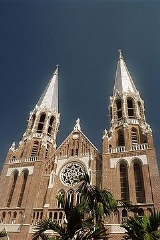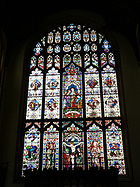
St. Mary's Church, Bury St. Edmunds
Encyclopedia
St Mary's Church is the civic church of Bury St Edmunds and claims to be the third largest parish
church in England
. It was part of the abbey complex and originally was one of three large churches in the town (the others being St James, now St Edmundsbury Cathedral, and St Margaret's, now gone).
There was a major renovation between the 14th and 16th centuries and it is at this point that the nave, its aisles and the tower were built. It is also at this time that Mary Tudor, favourite sister of Henry VIII, died and was buried in the church. Her tomb is in the sanctuary directly in front of the high altar. The church, however, is dedicated to Mary the mother of Jesus, and not, as some believe, to Mary Tudor.
During the 16th century, John Notyngham and Jankyn Smyth, two wealthy benefactors to the church, died and left generous amounts of money to the church. These funds contributed to building the north and south quire aisles, now the Lady Chapel and Suffolk Regimental chapel, two chantry chapels and a north and south porch.
The south porch was removed during a restoration in 1830s, and St Wolstan's chapel was added on the north-west side. The interior has been updated with modern utilities since then as well.
at cathedrals including Canterbury
and St Paul's
.
The current director of music is Peter Tryon, former organ scholar of Winchester Cathedral. The assistant director of music is Adrian Marple, former organ scholar of Hatfield College, Durham.

Parish
A parish is a territorial unit historically under the pastoral care and clerical jurisdiction of one parish priest, who might be assisted in his pastoral duties by a curate or curates - also priests but not the parish priest - from a more or less central parish church with its associated organization...
church in England
England
England is a country that is part of the United Kingdom. It shares land borders with Scotland to the north and Wales to the west; the Irish Sea is to the north west, the Celtic Sea to the south west, with the North Sea to the east and the English Channel to the south separating it from continental...
. It was part of the abbey complex and originally was one of three large churches in the town (the others being St James, now St Edmundsbury Cathedral, and St Margaret's, now gone).
History
The present church is the second building to stand on the site, the first being built in the 12th century by Mr Hervey. However, nothing survives of the Norman church and the oldest part of the existing building is the decorated chancel (c. 1290).There was a major renovation between the 14th and 16th centuries and it is at this point that the nave, its aisles and the tower were built. It is also at this time that Mary Tudor, favourite sister of Henry VIII, died and was buried in the church. Her tomb is in the sanctuary directly in front of the high altar. The church, however, is dedicated to Mary the mother of Jesus, and not, as some believe, to Mary Tudor.
During the 16th century, John Notyngham and Jankyn Smyth, two wealthy benefactors to the church, died and left generous amounts of money to the church. These funds contributed to building the north and south quire aisles, now the Lady Chapel and Suffolk Regimental chapel, two chantry chapels and a north and south porch.
The south porch was removed during a restoration in 1830s, and St Wolstan's chapel was added on the north-west side. The interior has been updated with modern utilities since then as well.
Choir
St Mary's has a traditional Anglican choir of boys and gentlemen, and has a long choral tradition spanning 600 years, which remained untouched even during Puritan times. The choir has toured to Spain, Turkey, Cyprus, Israel and Malta, and offers regular evensongsEvensong
The term evensong can refer to the following:* Evening Prayer , the Anglican liturgy of Evening Prayer, especially so called when it is sung...
at cathedrals including Canterbury
Canterbury Cathedral
Canterbury Cathedral in Canterbury, Kent, is one of the oldest and most famous Christian structures in England and forms part of a World Heritage Site....
and St Paul's
St Paul's Cathedral
St Paul's Cathedral, London, is a Church of England cathedral and seat of the Bishop of London. Its dedication to Paul the Apostle dates back to the original church on this site, founded in AD 604. St Paul's sits at the top of Ludgate Hill, the highest point in the City of London, and is the mother...
.
Organs and organists
The main organ is a four-manual instrument with 74 speaking stops. A second organ, a chamber organ, has four stops and is ideal as a continuo instrument where the main organ would be inappropriate. More details of the organs can be found at the National Pipe Organ Registerhttp://www.npor.org.uk/cgi-bin/Rsearch.cgi?Fn=Rsearch&rec_index=A00307.The current director of music is Peter Tryon, former organ scholar of Winchester Cathedral. The assistant director of music is Adrian Marple, former organ scholar of Hatfield College, Durham.
List of organists

- Ralph Guest 1796–1822
- Robert Nunn 1822–1863
- A. Lease 1863–1864
- Thomas Bentick Richardson 1864–1893
- Mr Kingston 1893–1896
- George W. Boutell 1897–1909
- Edward Percy HallamEdward Percy HallamEdward Percy Hallam was an English cathedral organist, who served in St Edmundsbury Cathedral.-Background:Edward Percy Hallam was born on 4 September 1887 in Nottingham. He studied the organ with James Kendrick Pyne at Manchester Cathedral....
1909–1937 - Clifton C. Day 1937–1942
- Dr Adcock 1942–1948
- Norman H. Jones 1948–1969
- John Fear 1969–1980
- David Ivory 1980–1982
- Peter Tryon 1983–

